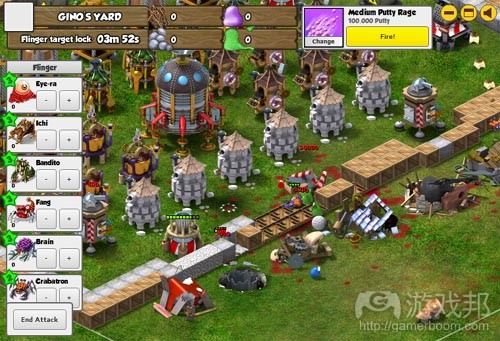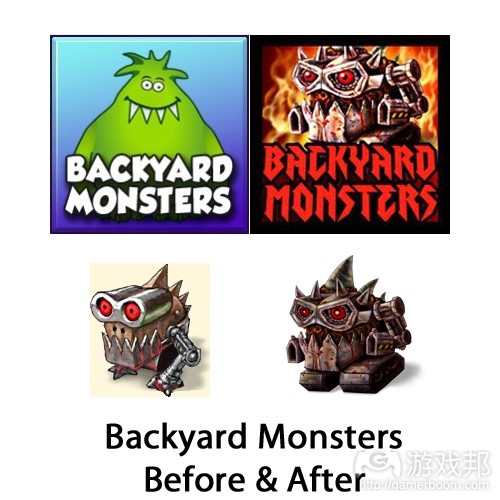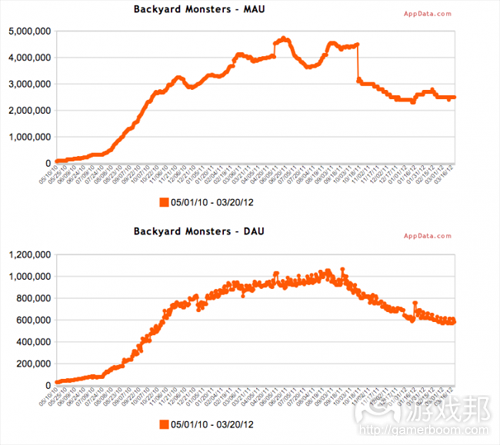Kixeye谈《Backyard Monsters》及公司发展历程
作者:Mike Thompson
《Backyard Monsters》这款Kixeye针对硬核玩家开发的Facebook策略游戏迎来了2周岁生日。
《Backyard Monsters》造就了其开发商现在的成就,让这家原本只是由几个好友合作创办起来的工作室得到迅速扩展,变成如今拥有超过数百名员工并坐落于旧金山市区的大公司。这是一款特别的游戏,因为在众多早前大获成功的Facebook游戏逐渐沉寂之时,这款游戏却持续“闪耀”于该平台上。如此可见硬核游戏也是Facebook游戏可瞄准的可行市场。
根据AppData数据显示,这款游戏现在仍拥有250万月活跃用户以及58万日活跃用户,拥有高达23%的用户留存率。尽管这一数值略低于其最高值时的450万MAU以及100万DAU,但是从去年10月以来这款游戏的流量就一直保持稳定状态。
Kixeye创始人Dave Scott最近阐述了《Backyard Monsters》过去两年的发展,以及他们通过游戏开发吸取的各种经验教训。
较低的起点
《Backyard Monsters》的故事开始于Kixeye还不是Kixeye,而是The Casual Collective的时候,该公司前身是由Dave Scott和Paul Preece这两个好友共同创建的Flash游戏门户网站。除了来自美国投资者所给予的资金外,Scott和Preece一直是通过视频广告以及付费订阅模式盈利。虽然这两种方式能够为该公司赚取一定收益,但是却不是长久之策。订阅模式更是问题重重——尽管这种方法比广告销售更能够盈利。
Scott说道:“很不幸的是我们不能从玩家身上获取更多收益。即使玩家想要支付给我们6美元的费用,但是订阅模式却只会统一收取5美元。”
The Casual Collective为其门户所创造的最后两款游戏是《Minions on Ice》和《TSG: Missions》——这两款游戏都有虚拟商品销售功能,并证实了开发者新创想的可行性。最初他们总是认为玩家不会愿意为超过零售价(游戏邦注:一般来说就是50美元至60美元)的内容掏腰包,但事实却证明,为了能够更深入地玩游戏,玩家甚至愿意投入多达200美元的费用去玩游戏。
尽管该公司的资金即将用尽,Scott和Preece仍决定搬至旧金山,创建一个开发团队并开始针对硬核玩家开发游戏,即《Desktop Defender》,这是一款塔防游戏,玩家需要在游戏中阻挡不断进攻的“creep”生物而保护桌面。这款游戏于2009年12月份发布于Facebook平台上,其最佳成绩是超过67万5千的MAU以及93万的DAU。这说明该公司冒险性的尝试获得了可观的回报。《Desktop Defender》一天所赚得的收益就比The Casual Collective之前一个月获得的收益还多。
改变美术风格
这款游戏在开发过程中面临的一大问题就是,它的风格对Facebook用户来说过于可爱了。在最终确定“Backyard Monsters”这个名字之前开发者考虑过许多名称,包括“Desktop Creatures”,“Gnometopia”等。而在游戏发行6个月后,开发者更是决定彻底改变游戏的设计风格,即将原本的家庭友好型图像改成更加血腥,刺激且吓人的生物设计样式。
这种风格转变是一个正确的决定。虽然Kixeye未详细透露相关数据,但是从该公司收到的玩家积极反馈以及游戏的每用户平均收入和玩家留存率的提升都可以看出这点。
开发者着重考虑的另外一点便是如何做才能让深层次的游戏玩法不会离间各种类型的策略型玩家。他们最初的计划是在游戏中添加技能树,让玩家能够升级怪物身体的不同部位,如完善腿部而让它更快速地奔跑或者添加智能而完善单位的AI。但是最终Scott却意识到这并不是一种有效的方法,因为即使是硬核玩家都觉得这种设置都太过复杂了,更何况普通玩家,所以他们便决定删除这一功能。
Scott表示:“很多游戏开发者总是难以取舍某些内容。孰不知舍弃也是一种进步的表现。尽管你觉得自己现在正在走回头路,但是你要清楚游戏可能会因为删减了这些累赘内容而变得更加完善。”
保持长期吸引力
最终证明这是一款大受欢迎的游戏,但是它却是在发布三个月后才真正闪耀光芒。它在发布三个月后,才获得将近50万MAU和17万5千的DAU。在这不久后,开发者便开始为游戏投入广告,以进一步推动游戏的发展。2010年末,《Backyard Monsters》的MAU突破了350万;并且在2011年的7月份达到了最高值450万。2011年4月,这家公司为自己重新注册了“Kixeye”这一名称,将自己定义为硬核Facebook游戏开发商。
虽然从那时起《Backyard Monsters》的流量开始逐渐下滑,但是这款游戏却真正证实了开发商的观点,即年长的女性并非Facebook游戏的唯一市场。《Backyard Monsters》的97%核心玩家都属于男性用户,并且他们每次玩游戏时间长达30分钟,玩家每天都会进入游戏3至4次。与此同时,该公司在2011年的收益与2010年相比更是增长了11倍之多;而这些收益主要是来自玩家购买游戏中的硬货币“shiny”并将其用于消费游戏中的虚拟商品。Scott还表示,游戏中85%的虚拟商品销量归功于玩家为快速完成单位生产而购买加速能源。Kixeye预计,如果继续按这种模式发展,他们在2012年的收益将可能突破9位数。
Kixeye营销高级副总裁Brandon Barber解释了硬核游戏玩家的心态对《Backyard Monsters》盈利性的影响:“你将会发现选择游戏的玩家都属于胜负心很强的玩家,他们不希望输掉游戏。如果你能够为他们提供战胜敌人的工具,他们便会愿意购买它。有时候看来这是一种盈利手段,但是有时候这也只是一种巧妙的游戏设置。因为考虑到大多数玩家都不希望输掉游戏,我们便更积极地提供那些能够帮助他们获取胜利的工具。”
每周的定期更新帮助这款游戏吸引到更多“回头客”,并且Kixeye也积极推动游戏的升级。去年他们在游戏中添加了地图室并设置不死的“冠军”怪物;而最近,他们更是扩展了Inferno内容,添加了一个强大的故事情节。
新游戏,新内容以及新平台
《Backyard Monsters》的成功推动了Kixeye的持续发展。在过去两年的时间里该公司也发行了其它两款策略游戏《Battle Pirates》和《War Commander》,但是却都未取得《Backyard Monsters》那般卓越的成绩,但这两者流量都稳定地保持在100万MAU和20万-23万DAU之间。这两款游戏都属于策略型游戏,但是它们更突出强调深层次的战斗系统,支持玩家在战斗期间直接控制单位——这一点与《Backyard Monsters》截然不同,在这里怪物进入敌人的基地时就会自主发挥战斗力。
当Kixeye在扩展着自己的游戏目录同时也未终止对于《Backyard Monsters》的更新。游戏的下一次大升级将基于最近的Inferno扩展添加一个新的冠军怪物。Scott告诉我们,现在的《Backyard Monsters》拥有无限的寿命;尽管大多数社交游戏开发者在游戏发行一年后都削减了游戏开发的相关人员,但是至今在Kixeye中仍有9名员工致力于该游戏的发展工作(根据Scott,“现在的开发团队可以说是该款游戏开发以来最大规模的一个团队”)。
除了每周的定期更新,《Backyard Monsters》计划在不久的将来向更广泛的用户群体开放服务。Barber告诉我们,Kixeye正致力于创建自己的平台并计划于六个月后正式发行。与Zynga.com一样,他们的新平台也无需玩家再次注册,只要通过Facebook Connect功能便能够连接至此;甚至没有Facebook帐号的玩家也可以直接在该平台上玩游戏。Barber解释道,他们希望通过创建这个平台而吸引那些没有Facebook帐号,以及那些不希望玩游戏还非得公开自己信息的玩家。
Barber说道:“对我们来说,这么做并不是想摆脱Facebook,更主要是一种实验性尝试。”
(本文为游戏邦/gamerboom.com编译,拒绝任何不保留版权的转载,如需转载请联系:游戏邦)
Two years later, Backyard Monsters continues to thrive on Facebook
Mike Thompson
Last week, Backyard Monsters — developer Kixeye’s bloody, goofy Facebook strategy game designed for hardcore video game fans — hit a major milestone: its second birthday.
Backyard Monsters made the developer what it is today, allowing the studio to grow from only a few friends working together to over a hundred employees in downtown San Francisco. The game is an anomaly, having lasted well past the point where most titles on the Facebook platform would be winding down toward sunsetting. Backyard Monsters also proved that hardcore gamers are a viable market to target on Facebook.
Currently, our AppData traffic tracking service lists the game at 2.5 million monthly active users and 580,000 daily active users for a very healthy retention rate of 23 percent. While that’s lower than the game’s all-time high of 4.5 million MAU and 1 million DAU, the numbers have been holding relatively steady since October.
Kixeye co-founder Dave Scott walks us through the past years with Backyard Monsters, sharing the lessons learned during the game’s continual development to apply toward the developer’s future — both on and off of Facebook.
Humble origins
Backyard Monsters’ story begins before Kixeye was Kixeye. Originally, the company was called The Casual Collective, a portal for Flash games founded by friends Dave Scott and Paul Preece. Aside from a healthy amount of startup money provided by an investor in the United States, Scott and Preece had been using video ads and paid subscriptions to generate cash. The Casual Collective was able to bring in money with these methods, but it wasn’t enough to be profitable. The subscription model was especially problematic, even though it was bringing in more money than ad sales.
“We’d unfortunately capped how much money we could make from players,” Scott said. “Even if a player wanted to give us $6, the subscription only let them spend $5.”
The final two games created by The Casual Collective for its portal – Minions on Ice and TSG: Missions — featured virtual goods, which proved to be an eye opener for the developer. The original belief was that gamers wouldn’t spend more than what a retail game cost (roughly $50 to $60), but it turned out that some players were willing to spend up to $200 to proceed through a game with a finite length.
Even though company funds were running low, Scott and Preece had enough left to move out to San Francisco, build a development team and start working on a game that would appeal to hardcore gamers: Desktop Defender, a tower defense game that tasked players with defending their desktop from invading creatures known as “creeps.” The game launched on Facebook in December 2009, peaking with just over 675,000 MAU and 930,000 DAU. To say that the gamble paid off is an understatement. Desktop Defender was making more money in a day than The Casual Collective could bring in over an entire month.
Secure in its newfound profitability, The Casual Collective began work on Backyard Monsters, a deep strategy game that could be played on Facebook. One of the key design ideas was that the title would include all elements that PC strategy fans loved, including making building placement integral to a base’s defense, as well as dynamic battles that were affected by which direction invaders came from and the order they attacked in.
From cute to crazed
One of the main concerns with the game during its development was that it wouldn’t be cute enough for the audience on Facebook. The game went through a number of working titles, including “Desktop Creatures” and “Gnometopia” before the developer settled on “Backyard Monsters.” Six months after launch, the developer decided to overhaul the art style, ditching the family-friend visuals for more blood, more guts and more intimidating creature designs.
The style change proved to be a well-received decision. Kixeye didn’t provide specifics about the results, but the company noted feedback from existing players was extremely positive and both average revenue per user and player retention increased.
Another concern was how deep gameplay could be without alienating a wide spectrum of strategy fans. Original plans included a skill tree that allowed players to upgrade different body parts of monsters, like improving legs to increase speed and adding brainpower to improve units’ AI. Ultimately, though, Scott realized this feature wasn’t going to work. He deemed it too hardcore for even hardcore players and decided to remove the feature from the game.
“Something that a lot of game developers have trouble doing is knowing when to cut something,” said Scott. “Cutting something out is still making progress. Even though it feels like you’re taking a step back, knowing that the game is going to be better without something that you just spent two weeks working on is going to result in a better game.”
An early success with lasting appeal
The game proved to be a hit, but it took almost three months before things really took off. Both MAU and DAU began gradually climbing; three months after launch, the game had roughly 500,000 MAU and 175,000 DAU. Shortly after this point, the developer started investing in advertising, which accelerated growth. By the end of 2010, Backyard Monsters broke 3.5 million MAU; the following July, it climbed to just over 4.5 million. The company also re-branded itself as “Kixeye” in April 2011 to help establish its identity as a developer of “core” Facebook games.
Since then, Backyard Monsters’ traffic has dropped off, but the game proved the developer’s point: that older women weren’t the only market for Facebook games. Even though 97 percent of Backyard Monsters’ core player base is male, the average play session is roughly 30 minutes. On top of this, the average player will put in three or four sessions a day. Meanwhile, the company was eleven times as profitable in 2011 as it was in 2010. Monetization comes from players purchasing hard currency called “shiny” and then spending it on virtual goods. Scott says 85 percent of virtual sales in the game come from players purchasing speed-ups to complete unit production. With this model and at this rate, Kixeye predicts that its revenue will break nine figures in 2012.
Brandon Barber, Kixeye’s senior vice president of marketing, explained how the hardcore gamer mentality works with Backyard Monsters’ monetization: “You see a type of user come in to play the game that is very, very, focused on winning. They don’t want to lose. If you give them the tools to ensure they have a strategic advantage over their opponents, they’ll take it. Sometimes it’s monetization, and sometimes it’s just smarter gameplay… most people don’t want to be on the losing side, so we offer them tools to help stay on the winning side.”
Weekly updates also keep players coming back and Kixeye made a point of providing major upgrades to the game. Last year, it was a map room addition and the implementation of powerful “champion” monsters that can’t be killed; more recently, the Inferno expansion added a strong narrative players could follow.
New games, new content and a new platform
Backyard Monsters’ success has allowed Kixeye to continue growing. Over the past year, the company launched two other strategy games: Battle Pirates and War Commander. While neither of these games enjoys the same level of traffic as Backyard Monsters, they’re both steady at nearly a million MAU and around 200,000 to 230,000 DAU. Both of these games are also strategy titles, yet they feature more in-depth combat systems that allow players to directly control units during a battle — as opposed to Backyard Monsters, where the creatures act of their own accord once they’re dropped into an enemy’s base.
Even as Kixeye expands its games catalog, work continues on Backyard Monsters. The next big upgrade will include a new champion monster, based on the recent Inferno expansion. Scott tells us that Backyard Monsters currently has an indefinite lifespan; whereas most other social game developers cut staff on a game down to a handful of people after a year or so, Kixeye currently has nine people working on the game (according to Scott, this is, “the largest development team in the entire history of the game”).
Aside from the regular weekly updates, Backyard Monsters is also expanding to a wider audience in the near future. Barber tells us that Kixeye is working on building its own platform to launch in the next six months. Much like Zynga.com, the new platform will likely allow players to sign in seamlessly and carry over their information via Facebook Connect, or play the games directly on the platform without having a Facebook account. Barber explained that the platform will primarily appeal to gamers who don’t have Facebook accounts and don’t want to play games that are tied to publicly available information.
“For us, this is less about trying to extract ourselves from Facebook and more about experimentation,” Barber said.
This new platform continues Kixeye’s legacy of taking chances and testing new strategies in order to appeal to an audience that is often overlooked by other developers. We’ll see if it the strategy works as well off of Facebook as it did for Backyard Monsters when it first launched on the platform two years ago.(source:insidesocialgames)
下一篇:成为优秀游戏制作人所需具备的素质










































 闽公网安备35020302001549号
闽公网安备35020302001549号